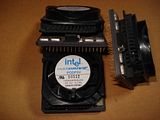First post, by Tetrium
- Rank
- l33t++
So I've been thinking...
After all the overclocking experiments we've come to the conclusion that one of the disadvantages of overclocking the POD83 is the inability to raile it's voltage. As Socket 3 boards generally only supply voltages between 3.3v and 5v and the POD83 is supposed to be run @ 5v, which it undervolts down to 3.3v, there is basically no headroom for tweaking the CPU voltage here (except maybe for underclocking).
This is because the POD83 uses an onboard (or on-chip) voltage regulator.
I've tried to take some pics of the regulator but this is hard as most of the regulator is being obscured by the glued-on heatsink.
Pics:
Overview pic of a couple POD83's. You can see the voltage regulator in between the ceramic and the heatsink (It's the black boxy thing in between the 4 smaller grey boxy thingies).

Closeup of the voltage regulator, from one side and from the other side.
Another thing that needs to be kept in mind is the fan mounted on the heatsink. It's a 5v fan powered directly from the CPU via the CPU socket.
It receives it's power from the 3 golden dots in the corner of the ceramic package (pic of the 3 golden dots here).
When the fan is removed from the 3 golden dots, the internal multiplier is reduced from 2.5x to 1x, creating another hurdle for overclocking as the tiny integrated fan can't be replaced by a generic fan without the POD83 doing it's underclocking.
The 2 thoughts I've been having are these:
1)What if the onboard voltage regulator were to be neutralised? And how could one accomplish this.
Would it be possible to simply "snip" the 3 metal legs of the voltage regulator? Or would it be required to do some extra soldering or some extra painting with conductive paint?
2)After having read the Intel datasheet (which is here) theres very little info about how the little Intel 5v fan is wired.
It uses 3 wires, of which 2 are probably for providing power (one ground and 1 5v, as per requirement of the fan) and 1 may be somekind of counter?
The question is: Which one of the 3 golden dots are for the counter and how could it be possible to "fool" the POD83 into thinking the fan hasn't been removed when it is?
Would it be possible to use a generic 3-pin fan, put it on 5v (just in case the "counter" wire of the generic fan starts sending 12v signals back to the 5v (regulated down to 3.3v?) of the POD83) and then somehow connect it to the correct golden dot?
I wasn't able to see the text written on the voltage regulator, but I have a broken Intel Overdrive (non-Pentium) I'm willing to destroy in order to see what voltage regulator is being used (should be roughly similar as it serves the same function that the POD83 regulator has, lowering the voltage from 5v to 3.3v).
Any suggestion, ideas, ...input?



